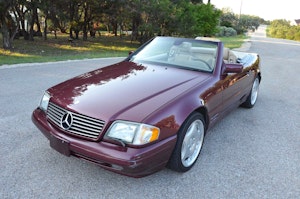Media | Articles
Moving on from my dad’s Ford Country Squire to a Mustang
A year after my dad died in 2002, I located and bought his old 1955 Ford. I thought I’d keep it forever. The Country Squire wagon was originally purchased by my great-uncle Eddie, who eventually gave it to my father, who sold it in 1993 when he needed some cash. Then, a decade later, Dad was gone, and I went searching for the Ford.
The then-owners weren’t looking to sell the old wagon, but they graciously agreed to after I laid on my sob story. Soon after, I took the Ford on a weeklong road trip to retrace the points of my dad’s life. Back then, I didn’t realize the car and my time with it were a way to grieve, a useful exercise for a guy starting his own family.
My dad used the Country Squire to get to the bus station and shuttle me and my sisters around on weekends. He didn’t drive it because it was cool. The wagon was a tool, a free car for a family that couldn’t afford a second one. As soon as he could, he bought another car, and the Ford sat in the garage until he sold it.


Marketplace
Buy and sell classics with confidence
20181112211157)
After I bought it, my own family and I drove it in parades and for ice cream runs, but I could tell that my kids didn’t share the nostalgia I had for the car. I understood why. I grew up in the Country Squire, but my kids haven’t. I finally decided to list the Ford when I realized it would be sold at some point, either by me or by my kids after I die. Why not sell now and replace it with a car that my kids might be more enthused about?
First, I called the folks who sold me the Ford, which seemed like the right thing to do. They were no longer interested, but a new buyer emerged who obviously digs the wagon. The thought of him enjoying the car with his friends and family simply felt right. And just like that, my dad’s Ford was gone.
My two sons, ages 15 and 9, already had a replacement in mind: a Mustang. Our $10K budget meant an early one was out of the question, which was fine by them because they had already zeroed in on 1990s Mustangs. In particular, they liked the so-called SN95 generation, produced from 1994–98. I can’t say I’m a fan of that model’s styling, but for the first two years of SN95 production, GT models still had the 302-cubic-inch pushrod V-8, an easy-to-modify engine with piles of available aftermarket parts.

Finding an SN95 Mustang around Detroit didn’t take long. A 40,000-mile 1994 model on Craigslist was pristine, obviously obsessed over by its recently deceased owner. His widow wanted her husband’s car to go to the right person, just as I felt about my Country Squire. I explained that we would not pamper the car like her late husband had but would yank the engine over the winter to have a project and plan a road trip for next spring. There were plenty of burnouts in the Mustang’s future. “Perfect,” she said. “Enjoy it with your kids.”
As I left her house, filled with the new-car glow, I once again realized how much cars are just a sideshow to what really matters. Owning a car helps us make personal connections, both deep and brief, that enrich the human experience. Modern life makes it easy to live in isolation, but the car is an uncommonly effective tool to help us break out of the bubble.
The article first appeared in Hagerty Drivers Club magazine. Click here to subscribe to our magazine and join the club.



















